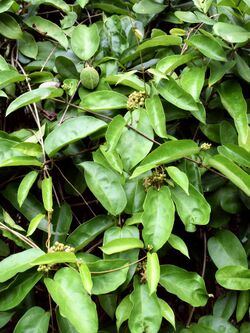Biology:Sarcolobus globosus
| Sarcolobus globosus | |
|---|---|

| |
| Scientific classification | |
| Kingdom: | Plantae |
| Clade: | Tracheophytes |
| Clade: | Angiosperms |
| Clade: | Eudicots |
| Clade: | Asterids |
| Order: | Gentianales |
| Family: | Apocynaceae |
| Genus: | Sarcolobus |
| Species: | S. globosus
|
| Binomial name | |
| Sarcolobus globosus Wall.
| |
Sarcolobus globosus is a twining shrub native to tropical regions of Asia including India, China, Thailand, Malaysia, Myanmar-Burma, the Philippines and Indonesia.
In India the plant is found in the mangrove forests of West Bengal, Orissa, Andhra Pradesh, Sundarbans and Andaman and Nicobar Islands. Traditional practices in these regions use the leaves and rhizomes as medicine; and the seeds are poisonous and used as bait to kill dogs and wild animals.
Description
The plant is a twining shrub with stout glabrous branches, root-stock thick, and fleshy; roots thick. Leaves are simple, opposite, 3-6x2-4.5 cm, ovate or oblong, thick and fleshy, acute or obtuse at apex, rounded at base. Inflorescence cymosely. Flowers small, starry, crowded, in axillary corymbose cymes, 2–3 mm across; corolla purplish, lobes pubescent inside. Follicles brown, 4–5 cm across, sub-globose; seeds are many and flattened. Cotyledons often large, radicle terete.
In the mangroves of India it is often found in association with and climbing on Phoenix paludosa.
Flowering and fruiting occur during June–September, October–January, respectively. In Andhra Pradesh fruiting is recorded as early as during August–October.
Chemical constituents
S. globosus is a rich source of flavonoids, rotenoids and phenolyc glycosides.[1][2] Rotenoids such as tephrosin, 12aalpha-hydroxydeguelin, 11-hydroxytephrosin, 12a-hydroxyrotenone, 12aalpha-hydroxyrotenone, 6aalpha,12aalpha-12a-hydroxyelliptone, 6a,12a-dehydrodeguelin, and 13-homo-13-oxa-6a,12a-dehydrodeguelin, villosinol and 6-oxo-6a,12a-dehydrodeguelin are identified. Isoflavones like barbigerone, genistin and a chromone 6,7-dimethoxy-2,3-dihydrochromone were identified. The isoflavone sarcolobone and the rotenoid sarcolobin were isolated from the stem and are unique to the species. Four phenolic glycosides including vanillic acid 4-O-beta-d-glucoside, glucosyringic acid, tachioside and isotachioside are reported.[3]
Uses
Poison
S. globosus is listed by the U.S. Food and Drug Administration (FDA) as poisonous plant. The seeds are known to be highly toxic to mammals. Native people of Asia widely use it to kill dogs and wild animals. It was demonstrated that it effectively killed cats,[4] and there are accounts of its use in Java in the 19th century to kill tigers.[5] The plant extract causes inhibition of the neuro-muscular system.[6] The symptoms of poisoning in animals include blood urine and nephrosis.[7]
Medicine
The plant has been used as an herbal medicine for treatment of rheumatism, dengue and fever. The plant is known to contain barbigerone which is validated to have significant antioxidant property,[3] highly effective against the malarial parasite Plasmodium falciparum,[8] and with anti-cancer potential as it causes apoptosis of murine lung-cancer cells.[9]
See also
References
- ↑ Wangensteen H; Alamgir M; Rajia S; Samuelsen AB; Malterud KE (2005). "Rotenoids and isoflavones from Sarcolobus globosus". Planta Med 71 (8): 754–758. doi:10.1055/s-2005-864182. PMID 16142641.
- ↑ Wangensteen H, Alamgir M, Duong GM, Grønhaug TE, Samuelsen AB, Malterud KE (2009). Chemical and biological studies of medicinal plants from the Sundarbans mangrove forest. In:Advances in Phytotherapy Research (M Eddouks, ed). Research Signpost,Kerala, India, pp. 59-78. ISBN:978-81-308-0223-7
- ↑ Jump up to: 3.0 3.1 Wangensteen H; Miron A; Alamgir M; Rajia S; Samuelsen AB; Malterud KE (2006). "Antioxidant and 15-lipoxygenase inhibitory activity of rotenoids, isoflavones and phenolic glycosides from Sarcolobus globosus". Fitoterapia 77 (4): 290–295. doi:10.1016/j.fitote.2006.03.017. PMID 16701962.
- ↑ Arokiasamy M (1968). "Toxicity of Sarcolobus globosus as observed in a cat". Malaysian Veterin J 4 (3): 196–199.
- ↑ Kerkhoven, R. A.; KERKHOVEN, E. J. (1883). "A Tiger Hunt in Java". Journal of the Straits Branch of the Royal Asiatic Society (12): 269–281. ISSN 2304-7534. https://www.jstor.org/stable/41560720.
- ↑ Mustafa MR; Hadi AHA (1990). "Neuromuscular blocking activity of a glycosidic extract of the plant Sarcolobus globosus". Toxicon 28 (10): 1237–1239. doi:10.1016/0041-0101(90)90123-O. PMID 2264070.
- ↑ Radostits OM, Arundel JH, Gay CC (2000). Veterinary Medicine: A textbook of the diseases of cattle, horses, sheep, pigs and goats (10th edn). Saunders Ltd., p. 1684. ISBN:0-7020-2777-4
- ↑ Yenesew A; Derese S; Midiwo JO; Oketch-Rabah HA; Lisgarten J; Palmer R; Heydenreich M; Peter MG et al. (2003). "Anti-plasmodial activities and X-ray crystal structures of rotenoids from Millettia usaramensis subspecies usaramensis". Phytochemistry 64 (3): 773–779. doi:10.1016/S0031-9422(03)00373-X. PMID 13679101.
- ↑ Li ZG; Zhao YL; Wu X; Ye HY; Peng A; Cao ZX; Mao YQ; Zheng YZ et al. (2009). "Barbigerone, a natural isoflavone, induces apoptosis in murine lung-cancer cells via the mitochondrial apoptotic pathway". Cell Physiol Biochem 24 (1–2): 95–104. doi:10.1159/000227817. PMID 19590197.
External links
| mode = cs1 | title = Sarcolobus globosus | work = Germplasm Resources Information Network (GRIN) | url = | publisher = [[Organization:Agricultural Research ServAgricultural Research Service (ARS), United States Department of Agriculture (USDA) | access-date = }}
Wikidata ☰ Q7423596 entry
 |

